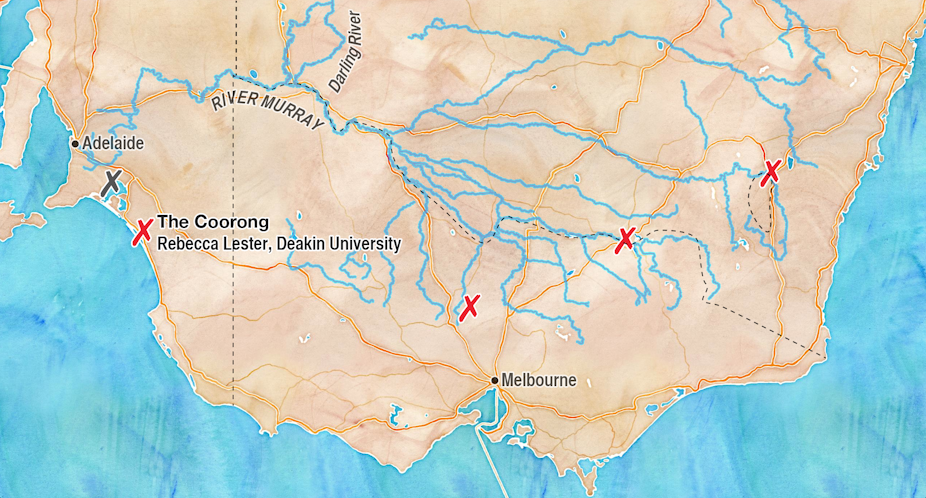The proposed Murray-Darling Basin Plan has been one of the most controversial pieces of public policy in Australia’s recent history. There has been the predictable divide between irrigators calling for more water to be extracted from the river, and environmentalists, who say too much is coming out already. But between the two, many experts are looking at the nuances of the plan and saying it’s a lot more complex than farming versus nature.
This week, researchers around the Basin will give us their view of how their local area has fared in recent years and tell us whether the proposed plan will make things better or worse. Today, Rebecca Lester, Lecturer at Deakin University’s School of Life and Environmental Sciences, looks at the Coorong, hard hit by the recent drought; she’s hopeful the plan will benefit the area’s ecology.
The Coorong is the estuary of the Murray-Darling Basin, where the Murray meets the sea. The Coorong is a Ramsar-listed Wetland of International Importance, meeting eight of the nine criteria for listing, illustrating its ecological diversity and importance. The Coorong is also the spiritual home of the Ngarrindjeri Nation, supports commercial fishery and agriculture and attracts thousands of recreational visitors each year.
The Coorong is the “end of the line” in the Murray-Darling, so is affected by activities upstream. For the last 15 years, the Coorong received less water from upstream than average. Extractions from the river effectively created a human-induced drought. This was exacerbated by recent severe weather-related drought, before returning flows in 2010-11.
The human-induced drought stressed the resident plants and animals, reducing their ability to withstand future strain. Less water resulted in lower water levels, higher salinity and reduced biodiversity. For many species, the harsh conditions limited habitat suitability, restricted their range, or prevented them from breeding or migrating.
When the weather-related drought then hit, the Coorong ecosystem had little resilience, or ability to recover from the additional stress. Water levels in the upstream Lower Lakes were so low that no fresh water was able to enter the Coorong for more than three years running. This situation was previously unrecorded and paleoecological evidence indicates it was unusual even for the last 7000 years.

The lack of fresh water had a dramatic impact. Water levels dropped; salinity rose to five to seven times the concentration of seawater; half of the Coorong (the South Lagoon) became a veritable “Dead Sea” with no aquatic plants, invertebrates living in the sediments or fish in the water column. Dredging of the Murray Mouth maintained the only connection of “fresher” water to the system by adding seawater.
Meanwhile, CSIRO developed a hydrodynamic model to simulate water and salt movement in the Coorong, based largely on upstream flows. A colleague and I at Flinders University developed a linked ecological model that simulates the response of birds, fish, aquatic plants and invertebrates to freshwater flows, salinity and water levels. This allowed us to explore alternative future scenarios for the Coorong, to help make decisions about the best management alternatives.
During the height of the drought, we used the models to identify the most promising emergency options (such as pumping salty water to the ocean, or additional dredging). We also took a longer view and, based on these models and other available science, developed a set of minimum flow requirements that should be sufficient to maintain the ecological health of the Coorong.
These environmental flow requirements provide a basis for assessing the likely effect of the Draft Murray-Darling Basin Plan (“the Plan”). Interestingly, avoiding ecological degradation in the Coorong appears linked with limiting times of very low or no flows. This is quite different to upstream floodplains, which rely on larger flooding flows to prevent ecological damage.

Also, the Coorong relies critically on how and when water is delivered, as much as the overall volume. For example, a given volume of water, delivered in late spring gradually, appears have a much larger effect on Coorong hydrology and ecology than the same volume delivered in winter over a few days. This means that it is difficult to specify a single volume that is “enough” water, because the amount that is “enough” changes depending on its delivery.
Based on this understanding, and the environmental water requirements for the region, the Plan represents a substantial improvement over the status quo. It provides additional water during dry times, thereby mitigating the human-induced drought that prevented the ecosystem from withstanding later weather-related drought. This makes it more likely that the ecological health of the Coorong will be maintained.
However, modelling indicates that in very dry times, like the recent drought, there would still be insufficient water to meet the minimum flows needed to prevent large-scale degradation. Thus, the Plan is currently a compromise. Insufficient water is likely to be available during very bad times, meaning that conditions like that described above could reoccur. Most of the time, however, it is likely that the Coorong would be in better ecological condition.
Recent returns of freshwater flows to the Coorong are improving its ecological health. Salinities are lower, water levels are high and there has been a return of connectivity that is allowing plants and animals to start to recover. But more than a decade of effective drought cannot be “fixed” by a single flow event, however large. Higher than average flows are likely to be needed to assist recovery for the next few years, at least.
Furthermore, the long-term health of the iconic Coorong relies on ensuring that minimum environmental water requirements are met or exceeded year-in and year-out. The current Plan goes part of the way to meet this goal, but room for improvement remains.

